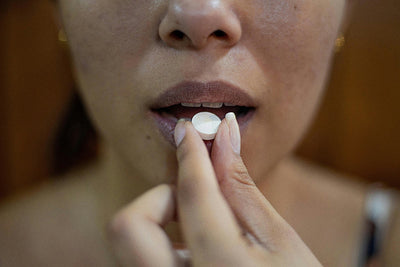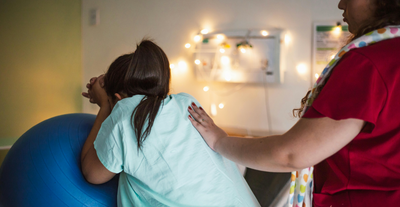Can Exercise Improve Breast Milk?
Can Exercise Improve Breast Milk?
by Katie Black
A lot of articles say it’s OK to exercise while breastfeeding. It won't hurt your milk supply and if you exercise moderately, you shouldn’t worry about lactic acid making your milk taste weird. But what if exercise isn’t only harmless to breast milk, and instead can actually improve it?
The effects of exercise on breast milk have been mostly ignored by the scientific community, but studies published in the last few years point to some potential benefits.
Study 1
One study published in 2020 in the journal Nature Metabolism looked at both mice and humans.
The researchers did an experiment on mice where they put pregnant females in two groups: one group exercised while the other stayed sedentary. All were fed a high fat diet. After giving birth, they switched the newborn mice between the two groups, so that babies from sedentary mothers nursed from active mothers, and vice versa.

At 52 weeks, male mice nursed by active mothers had several differences compared to those nursed by sedentary mothers, including:
- Lower body weight.
- Less body fat.
- Better glucose tolerance (ability to process glucose).
- Lower fasting insulin levels (associated with better blood sugar control).
- Improved insulin tolerance (better response to insulin after eating).
- Improved ejection fraction (efficiency of the heart pumping blood).
Interestingly, the effect of the moms exercising was less dramatic on the female babies’ health. Even so, at 52 weeks females that nursed from active mothers compared to sedentary mothers had:
- Less body weight.
- Less body fat.
- Improved glucose tolerance.
- Better cardiac function.
There wasn’t a difference between fasting insulin and insulin tolerance.
Next, the researchers took a closer look at which parts in breast milk could be causing these changes.
HMOs
Human milk oligosaccharides (HMOs) are special carbohydrates in breast milk important for a growing baby, and they help establish the microbiome. Human and rodent milk have a concentration of 5-15% HMOs (in cows they make up about 0.5%). While human milk has more than 150 different oligosaccharides, mouse milk contains only two oligosaccharides, 3′-SL and 6′-SL—both are also in human and cow milk.
To see if physical activity in moms has anything to do with the amount of specific HMOs in breast milk, the researchers noted the exercise of 139 women during pregnancy, then recorded HMO levels in their breast milk two months postpartum. They found a positive correlation between activity and 3’-SL concentration. In other words, moms who were more active also tended to have more 3’-SL in their breast milk, regardless of BMI. 6’-SL on the other hand wasn’t affected by BMI or activity.
Going back to the mice, the researchers wanted to know if an increase in 3′-SL was responsible for better metabolism and heart health in the babies. They used genetically modified mice that don’t have 3′-SL in their milk, and regular mice that do have 3’-SL. All were fed a high fiber diet and separated into sedentary or active.

Offspring from unmodified sedentary mice compared to modified sedentary mice had big differences in body weight, fat mass, and glucose tolerance, suggesting that a lack of 3’-SL can affect their metabolism.
Among the mice with no 3’-SL, exercising didn’t have a big effect on the metabolic or heart health of baby mice compared to being sedentary.
Overall, the researchers concluded that not having the HMO 3’-SL hurt exercise capacity, hurt glucose tolerance, and increased how at risk the mice were to the bad effects of a high-fat diet.
They went on to hypothesize that since exercise is correlated with 3’-SL in breast milk, and 3’-SL may play an important role in cardiac and metabolic health, exercising while pregnant and breastfeeding may help protect a breastfeeding baby from developing obesity, type 2 diabetes and cardiovascular disease later in life. But more studies need to be done to confirm this.
Study 2
Another study published in 2023 in the journal Frontiers in Nutrition looked at adiponectin, a hormone released by fat tissue. It helps with glucose and fat metabolism, and lower levels are associated with insulin resistance and type 2 diabetes. Some researchers have suggested that higher levels of adiponectin in breast milk helps prevent rapid weight gain in infants.
The 20 participants in the study were all exclusively breastfeeding for 6-12 weeks. They each completed a round of moderate-intensity continuous training (MICT), high-intensity interval training (HIIT), or no activity (rest).

For MICT, participants walked or jogged for 48 minutes, reaching a max heart rate of 70%. For HIIT, they did a 10-min warm-up at moderate intensity, then four workouts of four minutes bursts getting their heart rate up to a max of 90-95%, separated by 3 minutes of low to moderate activity. For the rest condition, participants sat in a chair for 45 minutes.
Samples of breast milk were collected before, immediately after, one hour after, and four hours after each condition.
The researchers found that the average concentrations of adiponectin went from 4.6 micrograms per liter before activity to 5.6 micrograms per liter an hour after HIIT—a boost of over 21%!

There weren't any notable changes in adiponectin concentration after MICT however.
While more research is needed, the study concluded that HIIT may increase adiponectin in breast milk and help prevent babies from becoming overweight or obese later in life.
Conclusion
While we’re still pretty far from being able to make strong conclusions on how exercise affects breast milk, these studies and others are laying the groundwork for the potential that exercise increases things in breast milk that help prevent obesity, type 2 diabetes, heart disease, and more. Breastfeeding is already going to give your baby a huge boost when it comes to these diseases, so if high intensity interval training isn’t in the cards for you right now, there’s no reason to stress.
If you want to know more about what’s in your milk, you can order a test here to get a unique nutrition label, and recommendations for optimizing your breast milk.
Sources:
https://www.ncbi.nlm.nih.gov/pmc/articles/PMC6571814/
https://www.frontiersin.org/articles/10.3389/fnut.2023.1275508/full
https://www.sciencedirect.com/science/article/pii/S0734975022001549
https://www.ncbi.nlm.nih.gov/pmc/articles/PMC8326052/
https://www.sciencedirect.com/science/article/pii/S0734975022001549
https://www.ncbi.nlm.nih.gov/pmc/articles/PMC2779028/
Picture credits: https://unsplash.com/photos/woman-exercising-indoors-lrQPTQs7nQQ






